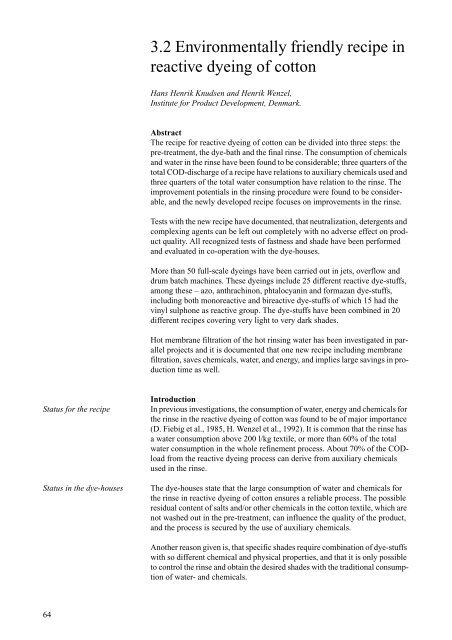Cleaner Technology Transfer to the Polish Textile ... - Miljøstyrelsen
Cleaner Technology Transfer to the Polish Textile ... - Miljøstyrelsen
Cleaner Technology Transfer to the Polish Textile ... - Miljøstyrelsen
You also want an ePaper? Increase the reach of your titles
YUMPU automatically turns print PDFs into web optimized ePapers that Google loves.
64<br />
3.2 Environmentally friendly recipe in<br />
reactive dyeing of cot<strong>to</strong>n<br />
Hans Henrik Knudsen and Henrik Wenzel,<br />
Institute for Product Development, Denmark.<br />
Abstract<br />
The recipe for reactive dyeing of cot<strong>to</strong>n can be divided in<strong>to</strong> three steps: <strong>the</strong><br />
pre-treatment, <strong>the</strong> dye-bath and <strong>the</strong> final rinse. The consumption of chemicals<br />
and water in <strong>the</strong> rinse have been found <strong>to</strong> be considerable; three quarters of <strong>the</strong><br />
<strong>to</strong>tal COD-discharge of a recipe have relations <strong>to</strong> auxiliary chemicals used and<br />
three quarters of <strong>the</strong> <strong>to</strong>tal water consumption have relation <strong>to</strong> <strong>the</strong> rinse. The<br />
improvement potentials in <strong>the</strong> rinsing procedure were found <strong>to</strong> be considerable,<br />
and <strong>the</strong> newly developed recipe focuses on improvements in <strong>the</strong> rinse.<br />
Tests with <strong>the</strong> new recipe have documented, that neutralization, detergents and<br />
complexing agents can be left out completely with no adverse effect on product<br />
quality. All recognized tests of fastness and shade have been performed<br />
and evaluated in co-operation with <strong>the</strong> dye-houses.<br />
More than 50 full-scale dyeings have been carried out in jets, overflow and<br />
drum batch machines. These dyeings include 25 different reactive dye-stuffs,<br />
among <strong>the</strong>se – azo, anthrachinon, phtalocyanin and formazan dye-stuffs,<br />
including both monoreactive and bireactive dye-stuffs of which 15 had <strong>the</strong><br />
vinyl sulphone as reactive group. The dye-stuffs have been combined in 20<br />
different recipes covering very light <strong>to</strong> very dark shades.<br />
Hot membrane filtration of <strong>the</strong> hot rinsing water has been investigated in parallel<br />
projects and it is documented that one new recipe including membrane<br />
filtration, saves chemicals, water, and energy, and implies large savings in production<br />
time as well.<br />
Introduction<br />
Status for <strong>the</strong> recipe In previous investigations, <strong>the</strong> consumption of water, energy and chemicals for<br />
<strong>the</strong> rinse in <strong>the</strong> reactive dyeing of cot<strong>to</strong>n was found <strong>to</strong> be of major importance<br />
(D. Fiebig et al., 1985, H. Wenzel et al., 1992). It is common that <strong>the</strong> rinse has<br />
a water consumption above 200 l/kg textile, or more than 60% of <strong>the</strong> <strong>to</strong>tal<br />
water consumption in <strong>the</strong> whole refinement process. About 70% of <strong>the</strong> CODload<br />
from <strong>the</strong> reactive dyeing process can derive from auxiliary chemicals<br />
used in <strong>the</strong> rinse.<br />
Status in <strong>the</strong> dye-houses The dye-houses state that <strong>the</strong> large consumption of water and chemicals for<br />
<strong>the</strong> rinse in reactive dyeing of cot<strong>to</strong>n ensures a reliable process. The possible<br />
residual content of salts and/or o<strong>the</strong>r chemicals in <strong>the</strong> cot<strong>to</strong>n textile, which are<br />
not washed out in <strong>the</strong> pre-treatment, can influence <strong>the</strong> quality of <strong>the</strong> product,<br />
and <strong>the</strong> process is secured by <strong>the</strong> use of auxiliary chemicals.<br />
Ano<strong>the</strong>r reason given is, that specific shades require combination of dye-stuffs<br />
with so different chemical and physical properties, and that it is only possible<br />
<strong>to</strong> control <strong>the</strong> rinse and obtain <strong>the</strong> desired shades with <strong>the</strong> traditional consumption<br />
of water- and chemicals.

















